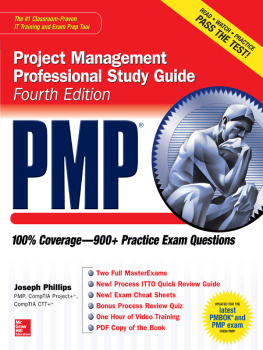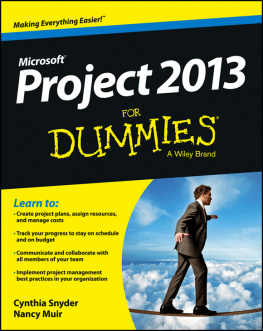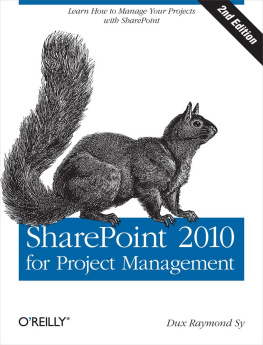SAP Project System Handbook
Kieron N. Dowling


Copyright 2008 by The McGraw-Hill Companies, Inc. All rights reserved. Except as permitted under the United States Copyright Act of 1976, no part of this publication may be reproduced or distributed in any form or by any means, or stored in a database or retrieval system, without the prior written permission of the publisher.
ISBN: 978-0-07-154451-1
MHID: 0-07-154451-8
The material in this eBook also appears in the print version of this title: ISBN: 978-0-07-154450-4, MHID: 0-07-154450-X.
All trademarks are trademarks of their respective owners. Rather than put a trademark symbol after every occurrence of a trademarked name, we use names in an editorial fashion only, and to the benefit of the trademark owner, with no intention of infringement of the trademark. Where such designations appear in this book, they have been printed with initial caps.
McGraw-Hill eBooks are available at special quantity discounts to use as premiums and sales promotions, or for use in corporate training programs. To contact a representative please e-mail us at bulksales@mcgraw-hill.com.
Information has been obtained by McGraw-Hill from sources believed to be reliable. However, because of the possibility of human or mechanical error by our sources, McGraw-Hill, or others, McGraw-Hill does not guarantee the accuracy, adequacy, or completeness of any information and is not responsible for any errors or omissions or the results obtained from the use of such information.
SAP, mySAP.com, mySAP Business Suite, and SAP NetWeaver are trademarks of SAPAktiengesellschaft, Systems, Applications and Products in Data Processing, Neurottstrasse 16, 69190 Walldorf, Germany. The publisher gratefully acknowledges SAPs kind permission to use its trademark in this publication. SAP AG is not the publisher of this book and is not responsible for it under any aspect of press law.
TERMS OF USE
This is a copyrighted work and The McGraw-Hill Companies, Inc. (McGraw-Hill) and its licensors reserve all rights in and to the work. Use of this work is subject to these terms. Except as permitted under the Copyright Act of 1976 and the right to store and retrieve one copy of the work, you may not decompile, disassemble, reverse engineer, reproduce, modify, create derivative works based upon, transmit, distribute, disseminate, sell, publish or sublicense the work or any part of it without McGraw-Hills prior consent. You may use the work for your own noncommercial and personal use; any other use of the work is strictly prohibited. Your right to use the work may be terminated if you fail to comply with these terms.
THE WORK IS PROVIDED AS IS. McGRAW-HILL AND ITS LICENSORS MAKE NO GUARANTEES OR WARRANTIES AS TO THE ACCURACY, ADEQUACY OR COMPLETENESS OF OR RESULTS TO BE OBTAINED FROM USING THE WORK, INCLUDING ANY INFORMATION THAT CAN BE ACCESSED THROUGH THE WORK VIA HYPERLINK OR OTHERWISE, AND EXPRESSLY DISCLAIM ANY WARRANTY, EXPRESS OR IMPLIED, INCLUDING BUT NOT LIMITED TO IMPLIED WARRANTIES OF MERCHANTABILITY OR FITNESS FOR A PARTICULAR PURPOSE. McGraw-Hill and its licensors do not warrant or guarantee that the functions contained in the work will meet your requirements or that its operation will be uninterrupted or error free. Neither McGraw-Hill nor its licensors shall be liable to you or anyone else for any inaccuracy, error or omission, regardless of cause, in the work or for any damages resulting therefrom. McGraw-Hill has no responsibility for the content of any information accessed through the work. Under no circumstances shall McGraw-Hill and/or its licensors be liable for any indirect, incidental, special, punitive, consequential or similar damages that result from the use of or inability to use the work, even if any of them has been advised of the possibility of such damages. This limitation of liability shall apply to any claim or cause whatsoever whether such claim or cause arises in contract, tort or otherwise.
Dedicated with love to my children: Damien, Fiona, and Tia.
About the Author
After some years as a tea, tobacco, and dairy farmer in Africa and the UK, Kieron Dowlings IT background has spanned in excess of 25 years in Zambia, Australia, Fiji, Papua New Guinea, and Europe. Beginning in the days of punch-cards and paper-tape, throughout his career he has worked with IBM mainframes, progressing to the successful design of medical, agricultural, real-estate, and myriad other packages for the early PC market of the 80s and 90s. He has two Australian Design Awards for his Medical and Dental software. SAP was the natural progression, and today he has over 13 years PS and IM experience under his belt as he continues to service the Oil, Engineering, Manufacturing, Mining, and most other high-end business disciplines. He is also the author of several fiction thrillers. He lives in Rome, Italy.
Contents at a Glance
Contents
Acknowledgments
SAP, naturally. Who have rekindled the professional lives of many a gifted dinosaur after the gradual decline of the mainframe! Thanks to Rettitiswarane Velayoudam for his contribution to the section on Project Progress under Tips and Tricks. I would also like to thank the staff of McGraw-Hill whose professional approach has made this possible.
CHAPTER 1
Introduction
This guide provides a concise reference to the most important aspects of the SAP R/3 PS module. Project System (PS) equates to anything that is project-oriented and has a life cycle. Apart from providing detailed background information about the features of PS, this guide includes useful reference information such as Transaction Codes, Report lists, Tables, and Fieldsvital when youre offline and need to refresh your memory.
One of the hardest things to communicate to those trying to implement business requirements in PS is the various methods by which things can be done. Questions range from How does PS work? to How can I distribute my planned costs over five years all in one go? to Why cant I see my Planned Costs? Reading this book should lead you in the right direction. It has been developed with a top-down approach, starting with the big picture and drilling down to detail as you progress.
Project System: An Overview of PS
In business, just about everything can be viewed as a Project. The decision to use PS depends on the degree of complexity and functionality desired. SAP R/3 has other modules that offer objects capable of emulating a projectProduction Planning, Sales & Distribution, Controlling with Internal Orders, and Customer Services, to name a few. But none has the depth of structure, integration, and complexity available in PS.
What exactly is PS? It is a repository for planning, collecting, and generating costs and revenue via a structure that truly represents what you are doing over a period of time. How simple is that? As simple or complex as you want it to be.
If it has a start, a middle, and an endits probably a project.
Everything associated with a project revolves around what SAP terms Work Breakdown Structures (WBSs) and Networks. These are the objects that do all the work and carry information about what the project will do. They can trigger events, schedule work, and generate demands for materials and services required to carry out the project.











